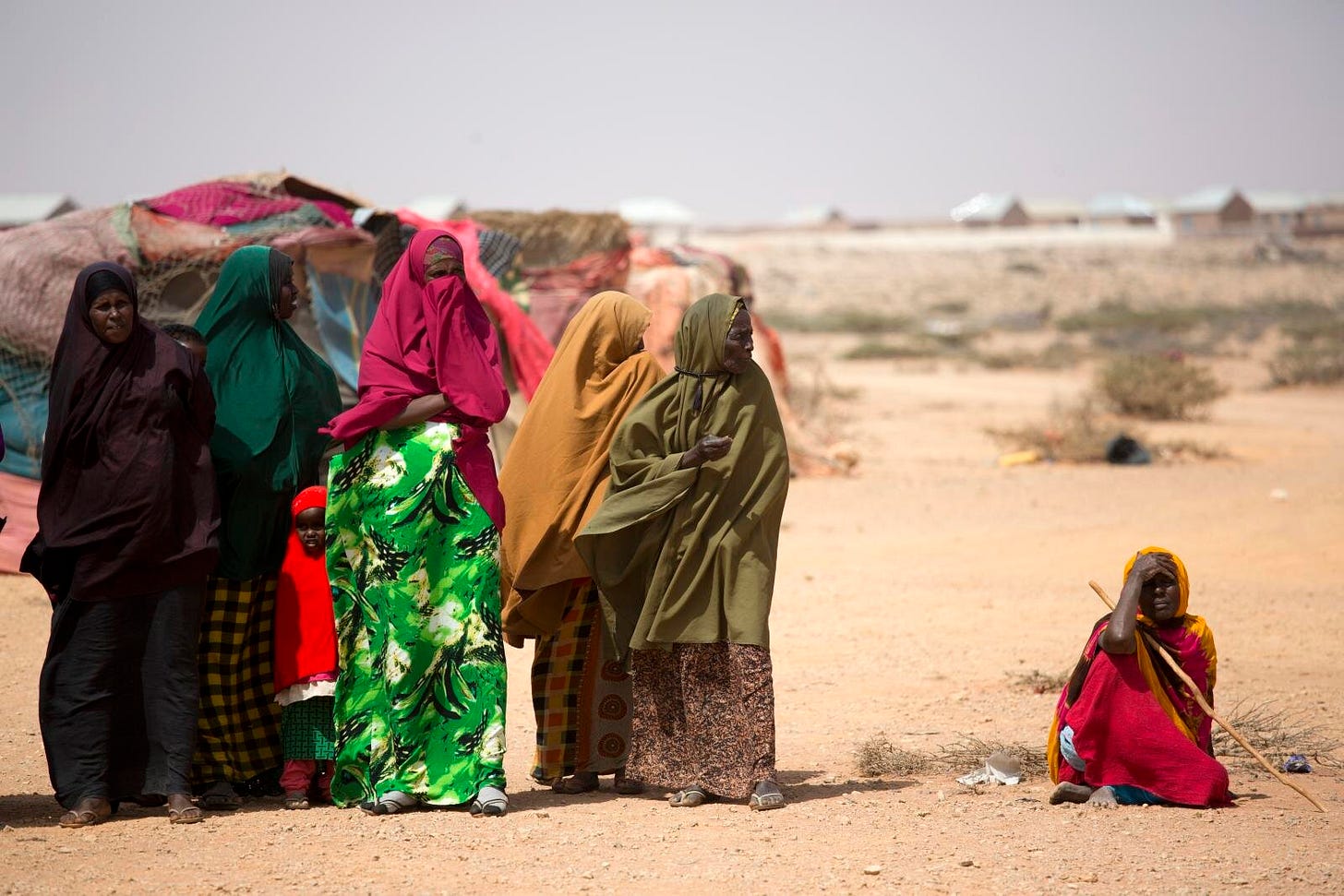The Climate Crisis and it’s effect on the lives of Somali women and girls
By Ojima Appiah
The reality of the climate change crisis in Africa, its effect on the lives of Somali women and girls, and recommendations for addressing the climate emergency.
Women in Africa bear the brunt of a deepening climate emergency. As major contributors to the unskilled African labour market- which is mainly agricultural and largely dependent on the natural environment for survival, women are extremely vulnerable to the compounding risks associated with climate change.
Climate change has affected the agriculture sector, worsened food and water security issues and galvanised local conflicts. From droughts in Somalia to flooding in Mozambique, extreme weather patterns have not only negatively impacted the quality of soil for food production, but have also affected animals and hampered irrigation solutions. Climate change has been linked to conflicts, including regional clashes and the internal displacement of people in some arid regions of Africa. Competition over scarce resources often creates tension among local people, which plays out in local or tribal disputes. In the Sahel region, paucity of resources has led to clashes between crop farmers and cattle herders.
Africa is disproportionately affected by climate change due to three factors. Firstly, Africa is over-reliant on its natural environment which places it in a precarious position- one that significantly hampers its ability for self-sustenance. Africa is extremely dependent on rain to grow crops and feed livestock, and disruptions in weather patterns impede these practices. Secondly, Africa’s encumbered resources have been placed under immense strain due to the fast pace of climate change. Many African countries lack the capacity, infrastructural preparedness and technological know-how to respond to the climate crisis. Thirdly, extensive research into the full extent of climate change in Africa is yet to be conducted. The region remains extremely vulnerable to climate change ‘unknowns’. As a result of these variables, the realities of climate change are magnified, more vicious and deeply crippling for African people, wildlife, the economy and society.
SOMALIA
Somalia, a notoriously dry country located in the Horn of Africa, has not been spared from the climate crisis. In recent years, the region experienced a 15 per cent drop in rainfall levels, resulting in drought, unreliable rainfall patterns, and disease. As a result, food and water security issues have worsened, aggravating tensions in the region, and forcing thousands of Somalis into overcrowded cities, refugee camps or the extremist group- al- Shabab. Currently, an estimated 2.6 million Somalis are internally displaced, with women alone accounting for 48 per cent of this figure. Somali women and girls have become the unintended victims of a deepening climate emergency.
GENDER-BASED VIOLENCE
Across many Internally Displaced Persons (IDP) sites in Somalia, women and girls face the risk of Gender-Based Violence (GBV), including kidnap, rape, and forced marriages, due to their vulnerable status as displaced persons. Women who leave campsites in search of water, firewood and other basic supplies face a high risk of being sexually abused, abducted or forced into marriages by their captors. Statistics indicate that 25% of Somali women in campsites have been subjected to various forms of GBV brought on by conflict and displacement, due to the climate emergency. Evidence suggests that a spate of domestic violence against women is being driven by mounting frustration, caused by environmental and financial hardships- linked to climate change. This plays out through violent expressions of masculinity, associated with an inability to provide basic necessities in the home.
HIGH POVERTY LEVELS
Somali women and girls face high levels of poverty and disenfranchisement, as a result of being internally displaced. Girls often stop their education to assist with households chores, which directly contributes to high female illiteracy rates, thus widening the gender inequality gap and worsening female poverty levels. While the IDP sites provide desperately needed shelter, girls lack access to basic sanitary supplies such as soap, detergent, underwear, toothbrush, toothpaste and menstrual pads, making them targets for sexual predators, who take advantage of their vulnerability and lure them into a life of physical and sexual servitude.
TERRORISM
Since 2000 the terrorist group al-Shabab has controlled large parts of Somalia. The group’s presence in the region poses a significant danger to displaced Somali women and girls who face the threat of either being forcibly married to al-Shabab fighters or incentivized into extremism by lucrative offers. This predicament places undue strain on the agency of Somali women and girls, who grapple with difficult decisions relating to survival. The intersectionality of risk factors such as age, gender, internal displacement, poverty and cultural norms, has worsened the impact of climate change for Somalia’s most vulnerable.
ADDRESSING CLIMATE CHANGE IN AFRICA: THE NEED FOR A GENDER-SENSITIVE APPROACH.
The Somali government is aware of the gendered impact of climate change on women and girls in the country and has committed to addressing the problem through its National Development Plan of 2020. But its ability to tackle the effects of climate change on women and girls in Somalia is significantly hampered by a weak government structure, crumbling infrastructure, the threat posed by al-shabab and more recently, the COVID-19 pandemic.
Due to this, policy options must be strengthened and addressed from an African perspective and subsequently streamlined to cater for the needs of individual countries. In doing so, African states must continue to use programs such as the African Adaptation Acceleration Program, but with a strong focus on gender, to mitigate the effects of climate change on the continent. It is crucial that recommendations be adapted towards a gender-sensitive approach to ensure that Africa’s response to the climate emergency does not ignore the needs of the most vulnerable.
The importance of a gender nuanced approach highlights the unique and differential experiences of those affected by climate change. A homogenous approach to climate change fails to underscore the seriousness and extent of the problem. For this reason, it is essential that the term ‘vulnerability’ be deconstructed to assess risk factors such as; age, sex, disability, socio-economic status, and ‘historical legacies’, which play prominent roles in the marginalisation of women within the context of climate change.
A gender-sensitive approach must provide practical, responsive and non-discriminatory policies that consider the needs of local women. Cultural norms exacerbate the climate problem by excluding women from the workforce, thus worsening female poverty levels and multiplying other vulnerability factors. A nuanced perspective challenges these “cultural beliefs that have denied equal opportunities and rights” to women and help to mitigate risk factors.
And finally, a gender inclusive climate change policy must involve local women at all levels of the decision-making process. There are valuable lessons to be adopted from local women who have introduced innovative and sustainable farming techniques, providing practical solutions to the climate debate in Africa.
Ojima Appiah is a political scientist, freelance writer, and founder of Writings of an African Bohemian, a blog she says was born out of a need to unpack discussions we hold at our dinner tables covering a myriad of topics including race, culture and feminism.
Ojima has lived in different parts of the world, something that has shaped her world view and informs her writing. She has notably worked at the Henry Jackson Society, focusing on radicalisation, and countering violent extremism in the online world.
You can connect with her on Twitter @BohemianAfrican and Instagram @the_african_bohemian




